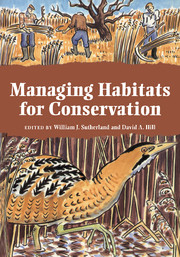Book contents
- Frontmatter
- Contents
- List of Contributors
- Acknowledgements
- 1 Introduction and principles of ecological management
- 2 Site management planning
- 3 Access
- 4 Coastal habitats
- 5 Rivers, canals and dykes
- 6 Waterbodies
- 7 Reedbeds, fens and acid bogs
- 8 Grasslands
- 9 Farmland
- 10 Lowland heathland
- 11 Upland moors and heaths
- 12 Woodland and scrub
- 13 Urban areas
- Some useful addresses
- Index of species by common names
- Subject index
9 - Farmland
Published online by Cambridge University Press: 05 February 2015
- Frontmatter
- Contents
- List of Contributors
- Acknowledgements
- 1 Introduction and principles of ecological management
- 2 Site management planning
- 3 Access
- 4 Coastal habitats
- 5 Rivers, canals and dykes
- 6 Waterbodies
- 7 Reedbeds, fens and acid bogs
- 8 Grasslands
- 9 Farmland
- 10 Lowland heathland
- 11 Upland moors and heaths
- 12 Woodland and scrub
- 13 Urban areas
- Some useful addresses
- Index of species by common names
- Subject index
Summary
Introduction
Farmland, for the purposes of this book, refers entirely to tillage or tillage and livestock (mixed) Systems in the lowlands, largely below an altitude of 300 m. Upland pastures and reseeded leys, dominated by livestock rather than tillage are considered in Chapter 11. Farmland which is devoted to cereals, other crops and horticulture accounts for 19.6% of the total land surface of Britain, with cereals alone accounting for 14.9%. This area is sixteen times the combined area given over to all Nature Reserves with statutory protection in the UK (Potts, 1991). For the context of management farmland comprises both cropped land and non-cropped land. The non-cropped habitats are generally remnants of those types discussed in other chapters but their management on the farm is fundamental to improving a farm for wildlife. Furthermore, their management is best considered as an integral part of the farmland landscape in a pragmatic and practical manner if the land manager or farmer is to undertake the work within the farm economy.
The ability to drain and till large areas of land with reduced labour, and the parallel increase in chemical fertilisers and pesticide treatments, followed by crop specialization and associated monoculture, has led to the greatest detrimental impact on wildlife diversity (Table 9.1). Such ‘intensification’ is defined as the exclusion of non-crop organisms (pests and competitors) leading to the maximum use of land for food production. Intensification has resulted in fragmentation and direct habitat loss such as hedgerow removal, pond infilling, woodland fragmentation, drainage of wet meadows and saltmarsh.
- Type
- Chapter
- Information
- Managing Habitats for Conservation , pp. 230 - 266Publisher: Cambridge University PressPrint publication year: 1995
- 7
- Cited by

